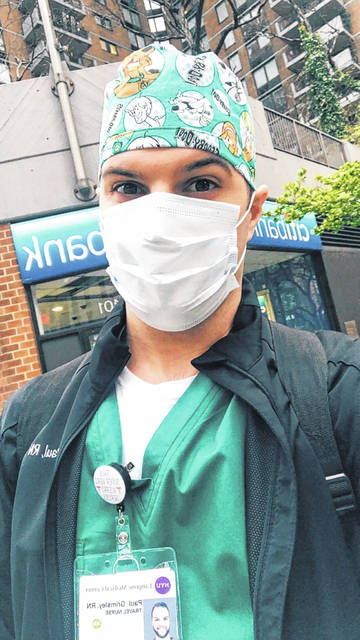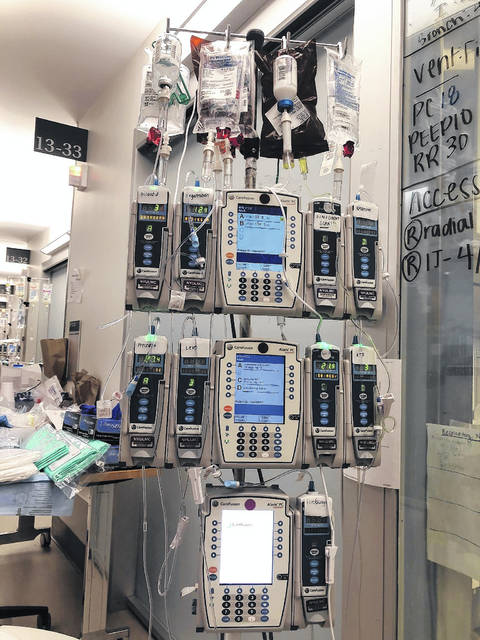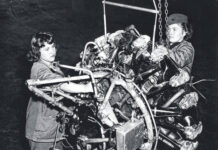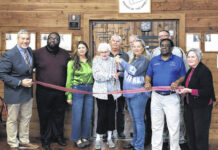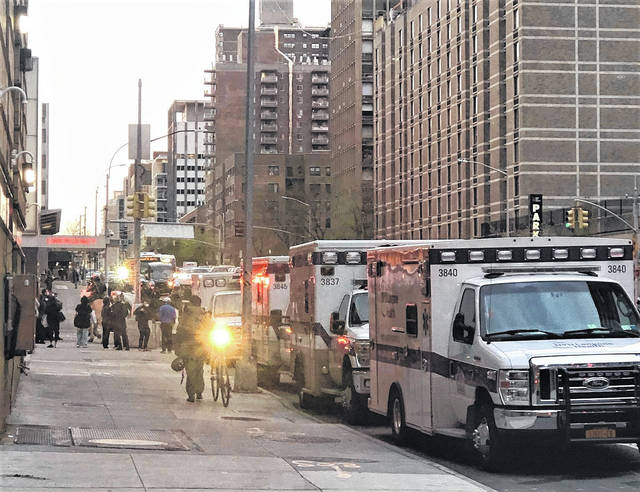
Ambulances bring patients into the New York University Langone Health Hospital in Manhattan, New York. Robeson County Intensive Care Unit nurse Paul Grimsley spent eight weeks at the hospital assisting with the care of COVID-19 patients.
Robeson County man spends eight weeks fighting COVID-19 in NYC hospital
MANHATTAN, N.Y. — Having the ability to adapt to stressful situations is important for an Intensive Care Unit nurse like Paul Grimsley.
The 31-year-old Fairmont native has spent the last decade of his life adapting to different hospitals and a variety of scenarios.
After graduating from Robeson Community College, Grimsley hit the ground running working in the ICU at Southeastern Regional Medical Center in Lumberton. After two years he moved on to New Hanover Medical Center in Wilmington and then to Duke University Hospital’s Surgical ICU.
“I was a travel nurse for the past year,” Grimsley said.
His training was tested over the past two months, when he chose to make his next mission the fight against the novel coronavirus, COVID-19, at the hardest hit state in the country, New York.
“My recruiter called me and asked if I would mind going to New York to kind of join the front lines,” Grimsley said. “I didn’t hesitate. I said, ‘Yeah, of course.’”
Grimsley arrived at New York University Langone Health Hospital in Manhattan on April 11. Going in, he figured out early that the entire realm of holistic nursing care was quickly placed on the back burner. Survival was at the forefront.
“We have to prioritize what all we need to do to keep this patient alive,” he said. “You didn’t have a lot of time for one-on-one care with the patient. It was just make sure the patient had their medicine and make sure their ventilators were working and move on.
“That was one of the biggest things that stood out. You gotta do what you gotta do and get to the next person.”
For eight weeks, Grimsley worked the night shift from 8 p.m. to 8 a.m.
“I was contracted to work 48 hours a week, but sometimes you weren’t always able to leave on time. Sometimes you would work 51 to 52 hours a week,” he said.
During the shifts, the nurse focused on no more than three patients at a time, but he never saw the same patient the next day. While still taking care of patients, Grimsley still had to limit the patient’s exposure.
“It was like I had to go in for an hour and do everything I needed to do at once and not come back for another two hours unless there was an emergency,” he said.
He felt safe at all times because an adequate amount of personal protective equipment was provided, Grimsley said. The nurses were required to be tested for COVID-19 and were screened daily with temperature checks. Luckily, the hospital, at the time, was not limited on masks either.
“If our masks were broke or we had worn it for too many shifts, we were allowed to go into the manager’s office and get another one, fortunately,” he said.
Grimsley found himself having to adapt and take charge in many cases while assisting health-care providers who were not critically trained but, like him, were answering the need because of the crisis.
“One night I worked with a pediatric plastic surgeon that was taking care of adult patients in the Intensive Care Unit. One night I worked with an ophthalmologist,” Grimsley said. “Some things they didn’t know, and as an ICU nurse you discuss with them ‘This is what I think, this is what I’ve seen in history. Let’s see if we can devise a plan together.’”
In the event that something critical did happen, they reached out to the attending physician, Grimsley said.
Despite the stressful environment, he never felt overwhelmed, Grimsley said. This is because of former training and experience, but also because of the man power on duty at the hospital.
“I think that because of the teamwork, we were able to manage everything,” Grimsley said. “I feel like when I got there, they kind of had a better handle on things. They had brought in an adequate amount of staff.”
What Grimsley did feel often, was helplessness.
“There were times were I felt helpless, like there was nothing else we could do for the patient,” he said. “With them not having family there, you’re trying to show that compassion with the patient but at the same time, there’s another patient that needs you.”
Grimsley is now back home in Robeson County and temporarily lending a hand at Southeastern Regional Medical Center and Scotland Memorial Hospital in Laurinburg, where there is a need, he said.
“Every hospital is different, and what you learn from one hospital you can bring to the next,” he said. “If you don’t like it, you’re only there for a few weeks and you can move on to what’s next.”
Grimsley is looking for his next mission, but he will never forget the time and service he gave in New York.
“It was definitely a great experience. If given the choice I would do it again,” he said.
Tomeka Sinclair can be reached at [email protected] or 910-416-5865.

